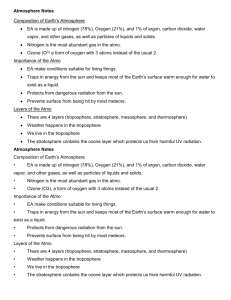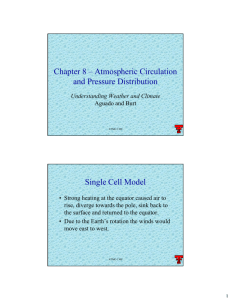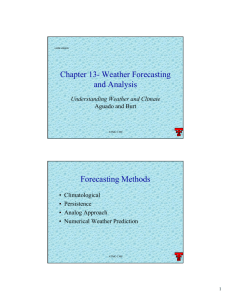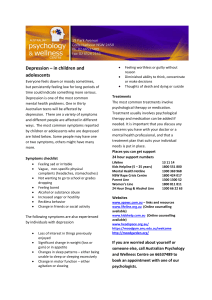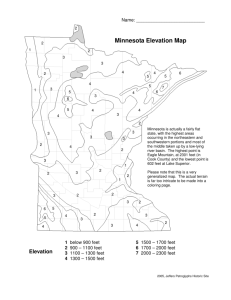Chapter 4 – Atmospheric Pressure and Wind Pressure
advertisement
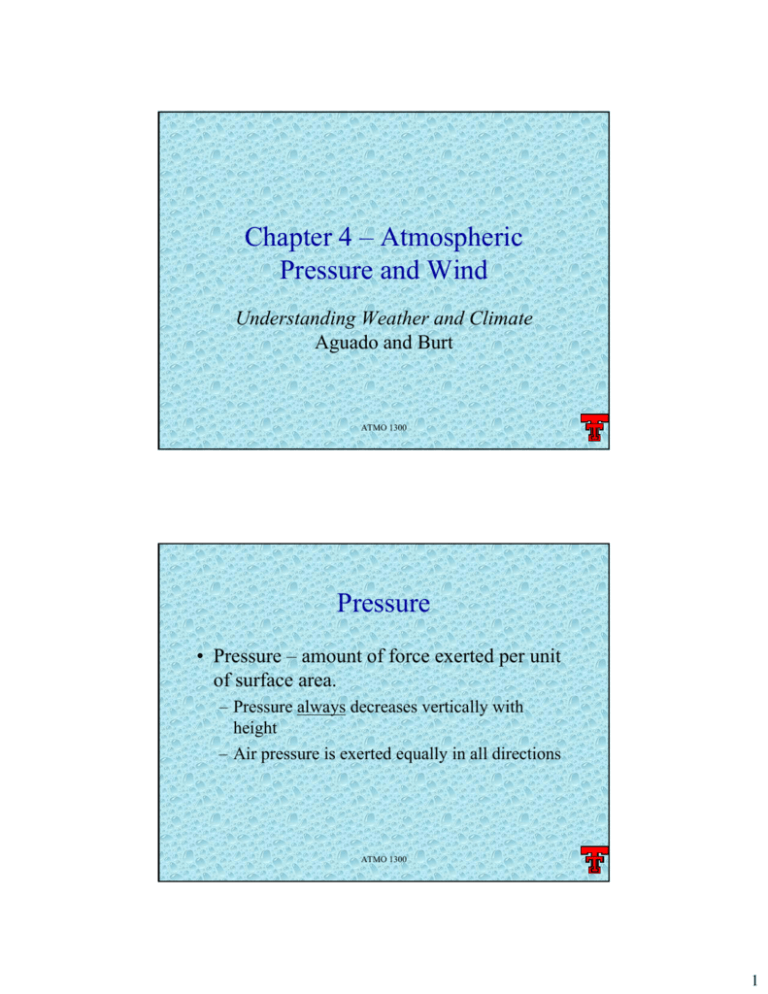
Chapter 4 – Atmospheric Pressure and Wind Understanding Weather and Climate Aguado and Burt ATMO 1300 Pressure • Pressure – amount of force exerted per unit of surface area. – Pressure always decreases vertically with height – Air pressure is exerted equally in all directions ATMO 1300 1 Pressure • Pressure of the air is proportional to the rate of collisions between the molecules and the wall • Increased pressure can result from – Increased density – Increased temperature • Air constantly moves from high to low pressure ATMO 1300 Vertical and Horizontal Changes in Pressure • Vertical – Pressure decreases with height – A small elevation change at low levels, results in a large pressure change • Horizontal – Changes are small relative to vertical changes ATMO 1300 2 Surface Pressure vs. Sea Level Pressure • Sea Level Pressure – the pressure that would exist if the observation point were at sea level. • Surface Pressure – the pressure observed at a particular location ATMO 1300 Equation of State • Ideal gas law – – – – p = ρRT P = pressure (Pa) ρ = density (kg/m3) T = temperature (K) R = gas constant (287 J/kg k) ATMO 1300 3 Pressure Measurement • Barometer – an instrument that measures pressure – Mercury barometer • Corrections include: elevation, expansion, acceleration of gravity – Aneroid barometer • No corrections ATMO 1300 Pressure Gradients • Pressure gradient – rate of change in pressure with distance • Isobar – line connecting points with exactly the same sea level pressure – Closely spaced isobars indicate a stronger pressure gradient and increased wind speeds – Horizontal pressure gradients are small relative to vertical ones. ATMO 1300 4 Hydrostatic Equilibrium • Hydrostatic Equation Δp = − ρg Δz • Gravity offsets the pressure gradient force which would accelerate the air upwards yielding hydrostatic equilibrium. ATMO 1300 The Role of Density on Pressure ATMO 1300 5 Horizontal Pressure Gradients in the Upper Atmosphere • Cold columns of air yield lower pressures at a given elevation and produce a horizontal pressure gradient. • A given pressure (example: 500 mb) level occurs at a lower elevation (height) for colder columns of air. ATMO 1300 Horizontal Pressure Gradients in the Upper Atmosphere ATMO 1300 6 Forces Affecting Wind Speed and Direction • • • • Pressure Gradient Force Planetary Rotation (Coriolis Force) Friction Gravity (affects vertical motion) ATMO 1300 Coriolis Force • Our ‘frame of reference’ is the surface. • The rotation of the Earth exerts a real impact on flying objects, causing an apparent deflection in their flight. • Equator – Motion is translational • Poles – Motion is rotational ATMO 1300 7 Coriolis Force • Coriolis force deflects all moving objects regardless of their translational direction. • Coriolis force is zero at the equator and maximum at the pole. • Coriolis force increases with an object’s speed. • Coriolis force changes only the direction of the moving object. ATMO 1300 Coriolis Force Fc = 2Ωv sin φ – – – – Fc = Coriolis Force Ω = Earth rotation v = Wind Speed φ = Latitude ATMO 1300 8 Friction • Air in contact with the surface experiences frictional drag, effectively slowing the wind speeds. • Planetary Boundary Layer (BL) – the lowest ~1.5 km of the atmosphere which experiences friction. • Free Atmosphere – the remaining atmosphere above the BL which is free from frictional effects. ATMO 1300 Winds in the Upper Atmosphere • Geostrophic wind – balance between pressure gradient and Coriolis forces. ATMO 1300 9 Winds in the Upper Atmosphere • Supergeostrophic – Coriolis force exceeds the pressure gradient force • Subgeostrophic – Pressure gradient force exceeds the Coriolis force ATMO 1300 Winds Near the Surface • Wind is slowed by friction • Coriolis force is reduced • Pressure gradient force exceeds Coriolis force and caused the wind to flow at an angle to the right of the pressure gradient force. ATMO 1300 10 Anticyclones • Enclosed areas of high pressure indicated by closed isobars or height contours ATMO 1300 Cyclones • Enclosed areas of low pressure indicated by closed isobars or height contours ATMO 1300 11 Troughs and Ridges ATMO 1300 Surface Map ATMO 1300 12 Upper Air Map ATMO 1300 Measuring the Wind • Anemometer – instrument to measure the wind. – – – – 3-cup anemometer Aerovane anemometer Sonic anemometer Hot-wire anemometer ATMO 1300 13 Measuring the Wind ATMO 1300 Wind Record ATMO 1300 14
